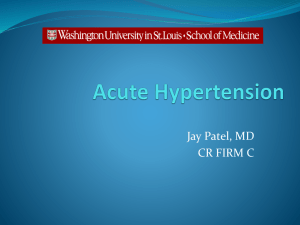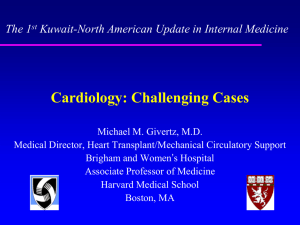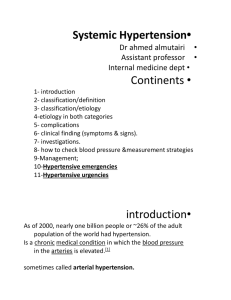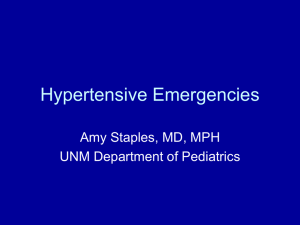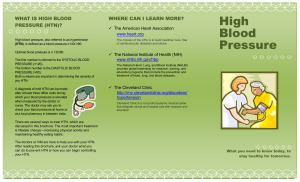Hypertension Protocol
advertisement
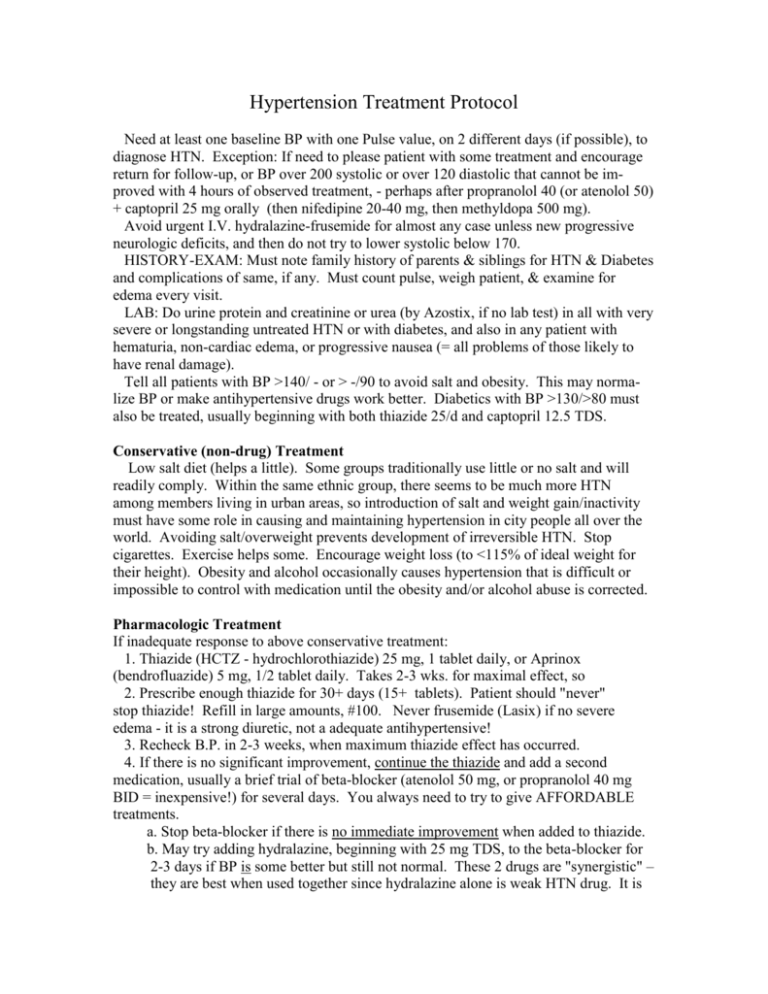
Hypertension Treatment Protocol Need at least one baseline BP with one Pulse value, on 2 different days (if possible), to diagnose HTN. Exception: If need to please patient with some treatment and encourage return for follow-up, or BP over 200 systolic or over 120 diastolic that cannot be improved with 4 hours of observed treatment, - perhaps after propranolol 40 (or atenolol 50) + captopril 25 mg orally (then nifedipine 20-40 mg, then methyldopa 500 mg). Avoid urgent I.V. hydralazine-frusemide for almost any case unless new progressive neurologic deficits, and then do not try to lower systolic below 170. HISTORY-EXAM: Must note family history of parents & siblings for HTN & Diabetes and complications of same, if any. Must count pulse, weigh patient, & examine for edema every visit. LAB: Do urine protein and creatinine or urea (by Azostix, if no lab test) in all with very severe or longstanding untreated HTN or with diabetes, and also in any patient with hematuria, non-cardiac edema, or progressive nausea (= all problems of those likely to have renal damage). Tell all patients with BP >140/ - or > -/90 to avoid salt and obesity. This may normalize BP or make antihypertensive drugs work better. Diabetics with BP >130/>80 must also be treated, usually beginning with both thiazide 25/d and captopril 12.5 TDS. Conservative (non-drug) Treatment Low salt diet (helps a little). Some groups traditionally use little or no salt and will readily comply. Within the same ethnic group, there seems to be much more HTN among members living in urban areas, so introduction of salt and weight gain/inactivity must have some role in causing and maintaining hypertension in city people all over the world. Avoiding salt/overweight prevents development of irreversible HTN. Stop cigarettes. Exercise helps some. Encourage weight loss (to <115% of ideal weight for their height). Obesity and alcohol occasionally causes hypertension that is difficult or impossible to control with medication until the obesity and/or alcohol abuse is corrected. Pharmacologic Treatment If inadequate response to above conservative treatment: 1. Thiazide (HCTZ - hydrochlorothiazide) 25 mg, 1 tablet daily, or Aprinox (bendrofluazide) 5 mg, 1/2 tablet daily. Takes 2-3 wks. for maximal effect, so 2. Prescribe enough thiazide for 30+ days (15+ tablets). Patient should "never" stop thiazide! Refill in large amounts, #100. Never frusemide (Lasix) if no severe edema - it is a strong diuretic, not a adequate antihypertensive! 3. Recheck B.P. in 2-3 weeks, when maximum thiazide effect has occurred. 4. If there is no significant improvement, continue the thiazide and add a second medication, usually a brief trial of beta-blocker (atenolol 50 mg, or propranolol 40 mg BID = inexpensive!) for several days. You always need to try to give AFFORDABLE treatments. a. Stop beta-blocker if there is no immediate improvement when added to thiazide. b. May try adding hydralazine, beginning with 25 mg TDS, to the beta-blocker for 2-3 days if BP is some better but still not normal. These 2 drugs are "synergistic" – they are best when used together since hydralazine alone is weak HTN drug. It is rarely effective without either 50-100 mg atenolol, 40-80 mg BID of propranolol 180-240 verapamil to control reflex tachycardia from hydralazine). But perhaps an unaffordable number of hydralazine tablets (2 X 3-4/day) might be needed. 5. If no significant improvement on hydralazine + either beta blocker, they both should be stopped. Try captopril 25-50 TDS in any patient with HTN on thiazide not helped by atenolol 100 mg/day or propanolol 80 mg BID (with or without the trial of the hydralazine - beta blocker combo). Can use hydralazine 50 mg TDS, if affordable. Do not use “-prils” in women of childbearing age - teratogenic if she conceives! Enalapril & lisinopril are longer acting & can be used 10-40 mg once daily but they are still too expensive in Africa in effective doses & not more effective than captopril. 6. Try nifedipine 40, 60, or, 80 mg in divided doses daily, usually with HCTZ 12.5 or 25 mg/day. Nifedipine 20 mg once daily is a low & ineffective dose. Amlodipine (Norvasc) is essentially the same type drug as nifedipine with same problems (dose 510 mg/day). It is expensive & rarely should be used if nifedipine available. Both can cause headache & bothersome leg edema which won’t improve with frusemide. Verapamil (below, #7) does not cause headache or edema but may cause constipation. 7. If you have it, you should try verapamil next, 80 mg TDS (or delayed release tablets 240/day). Dangerous bradycardia may occur prescribing verapamil with any beta blocker (atenolol, propranolol, or metoprolol) or with nifedipine (both are calcium channel blockers). 8. Use methyldopa as LAST CHOICE, up to 500 QID if needed & well tolerated, if nifedpine or verapamil fail. Clonidine 0.2-0.8 mg/d, or reserpine 0.25/day ) are other options. Use these 3 medications only if (1) helps BP & is clearly needed AND patient agrees to the frequent side effects. Partial correction of HTN is better than prescribing a regimen which controls HTN but which the patient does not like & will use irregularly if at all. Methyldopa often causes fatigue & impotence (rarely diarrhea & hemolytic anemia), clonidine always causes dry mouth & fatigue, and reserpine may cause depression & peptic ulcer – rarely if given only 0.25 mg/day. REFER ALL HYPERTENSIVE PATIENTS TO ENROLL IN A SPECIAL HYPERTENSION CLINIC. Personalizing care, building friendship and trust, gaining hypertension managements skills, and having acceptable results will take repeated contacts of your “specialist” with the same patients. It will be obvious to patients that they are not receiving any “specialty” care if they see every caregiver attending hypertensive patients while also attending other problems. It is always appropriate for all caregivers to check the BP on all OPD visits to identify any unsuspected hypertension, verify that any hypertensive medication being used is effective, and just to emphasize the importance of hypertension as a serious treatable disease, but do not refill BP medicines or substitute such a visit for a specialty clinic visit. A specialty clinic is best held at a unique location and scheduled time that distinguishes it from routine OPD care. Staffing must be consistent and the hypertension treatment protocol obviously being followed and on display. Inscribe all new patients on a special form kept in a separate Hypertension Clinic notebook, with home address and a contact person to avoid loss to follow-up care. Personal and family history should focus on issues relating to hypertension (especially compliance issues) and the exam on weight, presence of edema, & BP values. Use continuation sheets as necessary in the future. Emphasis is on very thorough history on the initial hypertension visit, often forgoing any exam other than body weight, BP in both arms, pulse rate, and a check for edema. The emphasis must always be on education and lowering “that number,” not on discussions and examinations that suggest that treatment will depend on patient complaints or physical abnormalities. The notation in the patient’s regular outpatient file could be as little as: “Hypertension Clinic visit” with date, weight, BP, medication recommendation & quantity, and date for return visit. Medication profiles Hydrochlorthiazide 25 mg, 1/2 to 1 tablet daily in all HTN. Slow onset of action but very effective in many patients! Except in renal failure, it is a MUCH stronger antihyper-tensive than Lasix, even in very low dose (Its action on BP has nothing to do with its action as a diuretic. Lasix is a strong diuretic but a weak BP drug!). Inexpensive, long duration of action, take once daily. Rare side effects if dose under 50mg daily. Synergistic with other B.P. medications (so never stop it), AND much evidence for prolongation of life in hypertension patients, unlike many other medications! Beta-blockers. Atenolol 50-100 mg/d or propranolol 40-80 BID. Inexpensive & ccasional1y very effective, so at least needs to be tried briefly. Works especially well and with rare side effects with hydralazine 25 mg, 1-2 TDS. Good evidence it prolongs life in HTN. Don't use in patients with severe asthma, and start out carefully in patients with asthmatic history if you must use it in asthmatics. Hydralazine 25 mg. Usually need to use with atenolol/propranolol to get good results. Must take at least 1-2 TDS to be effective, so inconvenient. May be a good choice to ADD if HCTZ + atenolol lowers BP but not quite enough. Not a good choice if need 6 or more pills daily - will then be more expensive than other choices below. Methyldopa 250 mg. Must give 2-3 doses/day, and HCTZ 1/2 + methyldopa 250 mg BID rarely controls BP. It takes 4 hours before exerting its anti-hypertensive effect. Frequent bothersome side effects - fatigue & sexual dysfunction. Safe & effective in PG & renal failure. Clearly prolongs life in HTN. ACE Inhibitors (the "-prils", - captopril, enalapril, lisinopril, monopril, ramipril, quinipril, etc. – the present inexpensive generic is captopril 25 mg) No bothersome side effects except cough (6%). Can use more expensive"-sartans" if "-prils" cause cough. Captopril needs TDS dosing (all other "-prils" can be given once daily). First dose captopril should be at least 12.5-25 mg TDS (other “-prils” start at least 10 mg/d), as some patients are very sensitive to it. Second dose can be twice the test dose and given same day if no lightheadedness-fainting. Conserves potassium - use instead of K supplement. Should use it in all diabetics with proteinurea or hypertension – protects kidneys in diabetes. Begin as above, 25 mg TID, usually with at least 12.5 mg HCT. Don't use if known renal failure unless you can monitor renal function 3-5 days after starting or increasing dose. Never use in pregnancy or young women not using contraception. Angiotensin receptor blockers, the ARBs or "-sartans", are a new family of drugs that are like the Angiotensin Converting Enzyme Inhibitors - ACEIs) or "-prils" in their action. Main advantage is that they do not cause the irritating cough as the -prils sometimes do. They are also teratogenic in PG and are not yet generic and therefore are very expensive. Calcium channel blockers, verapamil 40-80 mg TDS, nifedipine 20-40 mg BID , or amlodipine 5-10 mg/d. A lower dose does nothing. Avoid in any kind of heart disease. Verapamil slows pulse and main side effect is constipation. The others cause edema/headache. All can also worsen heart block or CCF, so do not use in CCF, with beta blockers, or if any heart block. Common areas for improvement in hypertension care: 1. All adults in OPD need BP recorded each visit whether “known hypertensive” or not. HTN is common in Africa, treatable, often fatal untreated, and ASYMPTOMATIC. Explain to all patients that finding and treating it early is IMPORTANT in health care. 2. Don’t deal with other problems or any symptoms at all when treating HTN – this detracts from your message that HTN is a silent killer. Most of the visit will be needed for education, pill count review, dietary counseling, etc., leaving no time for other complaints/prescriptions. This is difficult to do if you do not establish a Hypertension Clinic and change patient expectations of what hypertension care IS! It is NOT buying some pills periodically and talking about various aches and pains during visits! Spend more time on salt restriction & weight loss. If many doses are being omitted per “pill-count” verification, and patient does not improve, you may need to prescribe a simpler treatment regimen than you would like to ( fewer or less expensive pills, those with least side effects, or even just a single dose of longer-acting medication – especially thiazide). 3. Patients must always come with all their pills and must have taken their usual morning dose the day of that clinic visit to make this visit worthwhile. Discuss & make note in file. If no dose that morning, they don’t even understand the reason for monitoring visits! 4. Always record if patient took prescribed medication or not on day of BP visit. Recording the BP without documenting what patient took that day is not very useful HTN care monitoring. Yet, THIS IS ALMOST NEVER DONE, and patients commonly have taken nothing the day of visit, or for most past visits. 5. Don't do what previous caregivers have done if patient is noncompliant. Become an educator. Spend whole visit just talking about HTN – there is lots to say! Find out why and offer a more acceptable or convincing treatment program. Change treatment, dose, medication, appointment interval & time spent in education (often need 80% just talking, explaining!) to fit patient need. Always review medication compliance (even counting pills on hand, if control poor) and record whether correct dose was taken that morning! Make no change any in any medication if patient is not even on proper present treatment according to treatment protocol. Either have patient take the proper dose and recheck in 2 hours, or reschedule visit in a few days. 6. There is no benefit from any antihypertensive medication if BP is not lower on it or if patient just feels “fine”! Too many patients are on some antihypertensive "therapy" (even local herbs) who have little or no BP monitoring and have shown little or no BP improvement! This is not HTN treatment, even if patient thinks taking his local or your hospital-type pill “herbs” intermittently is beneficial! 7. Always use thiazide, in almost every patient who does not have renal failure, but in low dose, even ½ tab HCTZ or ¼ tab bendrofluazide (never over HCT 12.5 - 25 mg/day, or bendrofluazide 2.5 -5 mg/day). Thiazides take 2-3 weeks to have their maximal effect. 8. Don't use frusemide for hypertension except in renal dysfunction or with edema or fluid retention. This is the most common HTN error in Africa. It is a strong diuretic but a very weak antihypertensive. It lowers BP mostly by dehydration, like withholding water! It can be used to control edema or fluid retention caused by renal failure or heart failure or many of the usual hypertension drugs, but it is otherwise MUCH WEAKER than HCT for HTN. 9. Give beta blocker a brief try (after thiazides, the least expensive, & atenolol is taken once daily) for almost everybody not controlled with HCT 25 mg/day who doesn't have severe asthma. 10. Captopril is your first choice medication in diabetics. Need 3 doses daily - it is too short-acting to use 1-2 doses daily. Use with at least 12.5mg HCT daily. Do not use “-prils” in pregnancy or renal failure or with potassium supplements or with spironolactone). The “-prils” and “-sartans” both raise potassium, like spironolactone does. 11. You must weigh patients and check for edema on visits. I think it reasonable to get a fasting blood sugar & get a FBS if age over 40 when patients return after 2-4 weeks on thiazide if not done in past year. Diabetes eventually occurs in most obese, hypertensive black patients, so try to prevent it or delay its onset with weight control! It is a nasty disease with poor available treatments. If HTNis associated with edema or proteinuria you could do the creatinine or urea at same time. There is no need to repeat FBS more often than annually if no symptoms of high blood sugar or glucose in urine. 12. Do more trial treatments of HTN during the day of the visits in patients who are not controlled. You must work with them in your presence as some are unlikely to comply once they have returned home. Increase dose or change treatment and recheck BP 4 hours later (captopril works in an hour!), as long as patient has this serious disease and has taken the trouble and expense to come here. This may also avoid prescribing a medication or dose that will not work and avoid delayed treatment and expense for ineffective medication or insufficient dose. Only HCT has a long-delayed action and cannot be checked same day. Norman D. Olson, MD February 2004 Hypertension-Diabetes Clinic Form Name: File no. Birth date / / (dd/mm/yy) Ethnic Village Date enrolled in HTN-Diab Clinic / / Enrolling caregiver Friend/Family/hospital staff contact(s) Date Dx HTN / / ; Date onset thirst/polyuria ___/___/___ ; Date onset weight loss / / ; Date 1st diagnosis diabetes / / ; st 1 elevated blood glucose here: ; Date / / 1st elevated BP here: ; Date / / Last glucose: on / / ; Last BP: on / / Approximate weight at time of diagnosis HTN/DIAB: Lower Higher Same Weight at HTN/Diabetes Clinic enrollment today ______ Family history: HTN: Yes No; Diabetes: Yes No; Obesity: Yes No Salt use: none; minimal; moderate; lots (no restriction) History of cigarette smoking: Yes No; Still smoking? Yes No History of daily alcohol use: Yes No Last took HTN/Diab meds: today; 1-6 days ago; 1-3 weeks ago; 1-6 mos ago Specify longest period on any HTN/Diab meds without running out/stopping (= taking 75% of doses or most days of the week): wks mos yrs. Reason for stopping if stopped treatment (may check more than one): hoped for cure dislike continuous/chronic medication felt no better on treatment felt worse on treatment BP not better on meds given difficulty getting to OPD did not understand what hypertension is or the benefits of treating it financial difficulties Past HTN medications recalled by patient or recorded in file (if any) thiazide methyldopa -prils propranolol atenolol nifedipine hydralazine reserpine clonidine amlodipine clonidine Brenedin -sartans frusemide other: ____________ Is BP generally within normal limits (>75% of determinations) Yes No st Date 1 treated with outpatient insulin / / Date 1st treated with chlorpropamide/glibenclamide / / Date 1st treated with metformin / / Frequency of hypoglycemia symptoms: Q wk; Q month; rare; never Last annual eye check (for Diabetic patients) ___/___/___; Result __________________ Last urine protein check (for Diabetic patients) ___/___/___; Result_________________ Able to get BP taken elsewhere between visits to HTN Clinic? Yes No Present meds & dose: MED DOSE ________________________________________________________________________ ________________________________________________________________________ ________________________________________________________________________ NEED INITIAL EXAM FOR DIABETIC PATIENTS Follow-up notes: (Always: 1. Date; 2. Control; 3. Exam; 4. Educ/Compliance/Understanding) ________________________________________________________________________ ________________________________________________________________________ _______________________________________________________________________ ________________________________________________________________________ ________________________________________________________________________ ________________________________________________________________________ ________________________________________________________________________ ________________________________________________________________________ ________________________________________________________________________ ________________________________________________________________________ ________________________________________________________________________ _______________________________________________________________________ ________________________________________________________________________ ________________________________________________________________________ ________________________________________________________________________ ________________________________________________________________________ ________________________________________________________________________ ________________________________________________________________________ ________________________________________________________________________ ________________________________________________________________________ _______________________________________________________________________ ________________________________________________________________________ ________________________________________________________________________ ________________________________________________________________________ ________________________________________________________________________ ________________________________________________________________________ ________________________________________________________________________ ________________________________________________________________________ ________________________________________________________________________ ________________________________________________________________________ ________________________________________________________________________ ________________________________________________________________________ ________________________________________________________________________ ________________________________________________________________________ ________________________________________________________________________ Each DIAB visit: date, wt, BP, diet/med use/exercise?, hypoglycemia?, cigs, alcohol, foot check.

